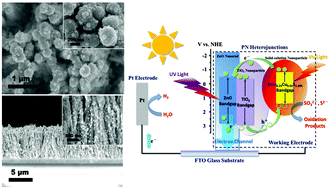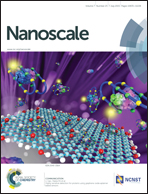Functionalized ZnO@TiO2 nanorod array film loaded with ZnIn0.25Cu0.02S1.395 solid-solution: synthesis, characterization and enhanced visible light driven water splitting†
Abstract
We have designed a novel semiconductor core/layer nanostructure of a uniform ZnO@TiO2 nanorod array modified with a ZnIn0.25Cu0.02S1.395 solid-solution on the surface via a facile hydrothermal synthesis. This novel nanostructure combines the merits of all components and meets the requirements of photovoltaic system application. An intimate PN heterojunction is formed from the ZnO@TiO2 nanorod and polymetallic sulphide solid-solution, which is remarkably beneficial for the effective visible light absorption and rapid charge carrier separation. The nanostructures exhibit higher photocurrent and incident photon to electron conversion efficiency (IPCE) under no bias potential versus the Ag/AgCl electrode. We also analyzed the interface and photoelectrochemical characteristics of the nanostructure and revealed the kinetic process of the electron and hole transmission. In addition, the photoanode test shows the hydrogen production capability of the nanostructures from solar water splitting. These results verified that the ZnO and TiO2 can be sensitized by the polymetallic sulfide for UV-Vis light driven energy conversion. Importantly, the approach we used to design the photoanode enables the development of micro-nano electronic devices with enhanced performance.


 Please wait while we load your content...
Please wait while we load your content...